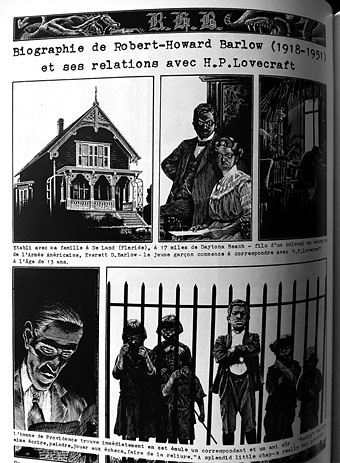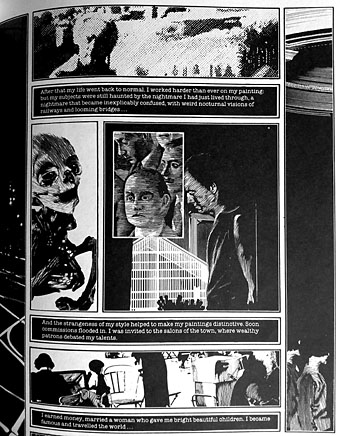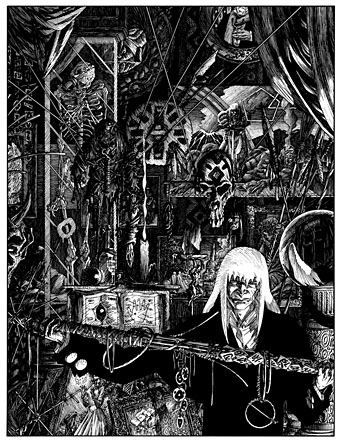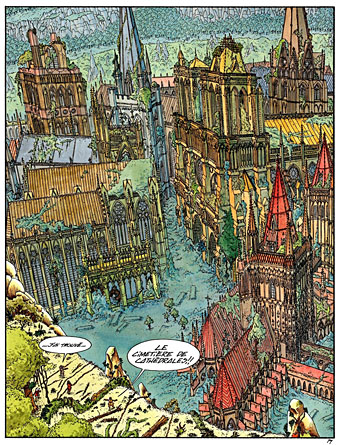Mention of Robert H. Barlow last week reminded me of a comic strip which is an unusual addition to the world of Lovecraft-related art. RHB, written by François Rivière and illustrated by Andreas (Martens), was published in a French magazine, À Suivre, in 1978. I discovered the story when it was reprinted in The Cosmical Horror of HP Lovecraft (1991), an Italian volume that was the first substantial collection in book form of Lovecraftian comic strips and illustrations. Andreas and Rivière’s strip is a short biographical sketch of Robert H. Barlow’s equally short life which focuses on his connections to HP Lovecraft but doesn’t attempt any spurious fictionalisation. A few of the pages were posted at Deep Cuts in June of this year, together with a translation of the French text. The post there notes something that hadn’t occurred to me before, that Rivière would have taken most of his information about Barlow from L. Sprague de Camp’s Lovecraft biography. The post also made me realise that the Cosmical Horror reprint is missing its last two pages, so after 30 years I finally discover that the panel sequence showing a falling cat (seen earlier being dropped from a height by the young Barlow) has a happy conclusion that also ends the strip itself.
The Spitzner Museum’s Wax Woman.
Andreas has been a favourite comic artist of mine for many years, thanks in part to strips like RHB with its combination of unorthodox page layouts, scraperboard drawings (scratchboard, if you’re American) and the occasional use of enlarged half-toned photos. The scraperboard technique can be a laborious one for a comic artist, especially when applied in a photo-realist manner, which may explain why Andreas has used a more stylised pen-and-ink rendering for many of his own books, the drawings of which often resemble the engraving-like illustrations of Franklin Booth. The only other Andreas strip I’ve seen to date that uses scraperboard is The Spitzner Museum’s Wax Woman, another collaboration with Rivière which relates the ill-fated encounters of a Belgian painter with the woman of the title. The story received its first English printing in issue 17 of Escape magazine in 1989, and its appearance there made Andreas an artist to look out for in the future. The museum tale and the Barlow story were collected with several similar pieces in a book collection, Révélations Posthumes, in 1980. I’d really like to see this even though my French is très pauvre:
Avec ce livre, vous découvrirez d’étonnantes révélations posthumes concernant la vie fulgurante d’un ami et confident de Lovecraft, l’étrange aventure survenue en 1926, à Hastings, à un orphelin et une mystérieuse Thérèse Neele. La rencontre d’un soldat nommé Raymond Roussel et de Jules Vernes, à Amiens. Les origines du talent morbide d’un peintre belge fasciné par les figures de cire du Musée Spitzner. L’avatar maléfique joué à un malheureux jeune Anglais par Pierre Loti en sa maison de Rochefort-sur-Mer.
Rork.
Révélations Posthumes seems to have been a one-off for Andreas. His subsequent, self-written books are more commercial fare, being a succession of weird adventure stories which follow the exploits of eccentric characters such as Cromwell Stone (an occult detective), the ageless, enigmatic Rork (a white-haired magus and occult detective), Capricorne (an astrologer and occult detective), and so on. As with Philippe Druillet, Lovecraft is never far away: the first episode of Cromwell Stone opens with an epigraph from HPL’s Supernatural Horror in Literature, while elsewhere inexplicable leviathan entities lurk in parallel dimensions, and architectural anomalies abound. The Rork series is especially enjoyable, like Doctor Strange without the superhero histrionics, featuring wildly audacious storylines such as Le Cimetière de cathédrales (1988), in which a graveyard for cathedrals is discovered in the Amazonian jungle.
The fantasies of Andreas, like those of François Schuiten, might be more familiar to Anglophone readers if his works had been translated more often (or, in the case of RHB, translated at all). Dark Horse ran English versions of stories by Andreas and Schuiten in their Cheval Noir anthology series in the 1990s, and also published English reprints of the Rork and Cromwell Stone books but, as with the translated editions of Schuiten, these are now hard to find. More recently, Titan Books has published a new English edition of the first Cromwell Stone book but I’ve not seen any indication that they’ll be following this with more of the same. (I’ve also not seen the book itself so can’t vouch for the quality of the translation. Titan’s recent Druillet reprints have been riddled with textual errors. Beware.) Rather than wait for translations that might never arrive, the better option would be to improve my French reading skills. Writing this post has prompted me to order a secondhand copy of Révélations Posthumes. I’m looking forward to seeing what else it contains.
Elsewhere on { feuilleton }
• The Lovecraft archive
Previously on { feuilleton }
• Lovecraft: Démons et Merveilles
• The art of François Schuiten
• The art of Andreas Martens





One thought on “Andreas, HPL and RHB”
Comments are closed.